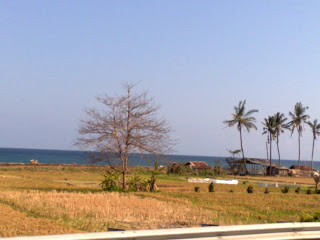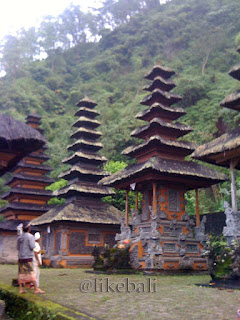 Uluwatu, which is located at the southern tip of Bali island and towards the Indian Ocean, is a charming tourist attractions.
What is interesting to see here is a temple that stands firmly upon the rock that juts into the sea to a height of about 50 meters. In the afternoon enjoying the beautiful sunset, you can watch the famous Balinese dance performances up to foreign countries, the Kecak dance.
Not only that, for those of you who enjoy learning history, pretending that one is full of historical value. History will be outlined as follows:
Uluwatu, which is located at the southern tip of Bali island and towards the Indian Ocean, is a charming tourist attractions.
What is interesting to see here is a temple that stands firmly upon the rock that juts into the sea to a height of about 50 meters. In the afternoon enjoying the beautiful sunset, you can watch the famous Balinese dance performances up to foreign countries, the Kecak dance.
Not only that, for those of you who enjoy learning history, pretending that one is full of historical value. History will be outlined as follows:
In some sources said, about the year 1489 AD came to the island of Bali a purohita, writers and clergy named Danghyang Dwijendra. Danghyang Dwijendra is a Hindu priest, born in Kediri, East Java. Danghyang Dwijendra named at walaka Nirartha. He married a daughter in Daha, East Java. In that place he also studied and in-diksa by-law. Nirartha awarded bhiseka kawikon as Danghyang Dwijendra.
After in-diksa, Danghyang Dwijendra a duty to dharmayatra as one of the requirements kawikon. Dharmayatra should be implemented on the island of Bali, with the addition of a very heavy task of arranging in-law customary and religious life, especially in the island of Bali. If necessary it can be forwarded to dharmayatra Sasak and Sumbawa Island. Danghyang Dwijendra came to the island of Bali, first set foot on the outskirts of the southwestern coast Jembrana for a moment to rest before continuing the journey dharmayatra. Where Danghyang pemutik Dwijendra left (there is also mention pengutik) with shaft (starch) wood rack. Starch wood shelf life and it turned into a tree thrives rack. Until now the leaves are used as a complete wood shelf offerings in Bali. As a memorial and tribute to him, built a temple named Purancak. After holding dharmayatra Sasak and Sumbawa Island, Danghyang Dwijendra heading south western tip of the island of Bali, which is the arid region, full of rocks called the hills. After some time living there, he was getting calls from the Creator to get back amoring acintia Parama moksha. This is where Ida Rauh Wawu (icang eling) with Samaya (promise) himself to return to his home. That's why this place is called Cangeling and gradually became Cengiling until now. Hence, Ida Rauh Wawu ngulati (find) a place deemed safe and appropriate to do Parama moksha. Therefore deemed ineligible, he moved again to another location. In this place, then built a temple called Pura toadstool. The name was derived from the word ngulati. The temple is located in the village of Pecatu. While walking to get a new location deemed eligible for Parama moksha, Ida Rauh Wawu very sad and crying inside her. Why? Because he was not willing to leave this world scale because swadharmanya not felt completely, which organize the Hindu religion in the Sasak and Sumbawa. At this point he mengangis, and built a temple called Pura cry (tears origin of the word). Temple is located in Banjar cry Middle Pecatu Village People. Ida Rauh Wawu have not found a place that is appropriate for Parama moksha. He then came to a place full of big rocks. He felt alone. In this place, and built a temple called Pura Batu Diyi. Also in place is Danghyang Dwijendra feel less safe for Parama moksha. With quite a tiring journey hunger and thirst, he finally arrived at the hills that always gets scorching sun. For the umbrella away, he took a piece of leaf beetles and try to get drinking water. After the tour did not find the source of drinking water, Dwijendra Danghyang finally stuck his stick. Amertha water came out. In this place and built a temple called Pura Umbrella with springs that are used Tirtha means until now. Ida Rauh Wawu then moved again to another location, to amuse themselves before carrying out the seconds back to the origin. In this place and built a temple called Pura Selonding located in Banjar Kangin Pecatu Village People. Once satisfied to entertain themselves, Danghyang Dwijendra feel tired. So he was looking for a place to rest. I was so tired to the point that he was quiet (asleep). In this place and built a temple called Pura Parerepan (parerepan means pasirepan, inn) located in the village of Pecatu. Approaching the final seconds to Parama moksha, Danghyang Dwijendra purify themselves and mulat sarira first. In this place until now there stood a temple called Pura Banjar Pangleburan Kauh located in Pecatu Village People. After purifying himself, he continued his journey to the location of the southwestern tip of Bali. The place consists of rocks of the cliff. When observed from below the sea surface, seem mutually overlapping, shaped head perched atop the cliff rocks, with a height of between 50-100 meters above sea level. Thus called Uluwatu. Ulu meaning the head and Watu meaning stone. Before Danghyang Dwijendra Parama moksha, he called the boat skipper who had taken her from Sumbawa to Bali. Boat skipper named Ki Pacek Nambangan boat. The Pandita asked for help to skipper a boat carrying clothing and stick to his fourth wife in Puri Sakti pasraman in Banjar Pule Mas, Mas Village, Ubud, Gianyar. Clothes in the form of pale green silk robe and a wooden stick. After Ki Pacek Nambangan boat headed pasraman Danghyang Dwijendra in Mas, Ida Rauh Wawu soon to a big rock on the east heap stones former kingdom relic temple Sri Wira Dalem Kesari. On top of that rock, Ida Rauh Wawu mengranasika yoga, like a dagger off was so urangka, disappeared without a trace, amoring acintia Parama moksha. Additionally at Uluwatu beach area with large waves is very challenging to surf sports lovers. Each year the event is always held at the international level adjacent seputaran Uluwatu beach.(e-kuta)







